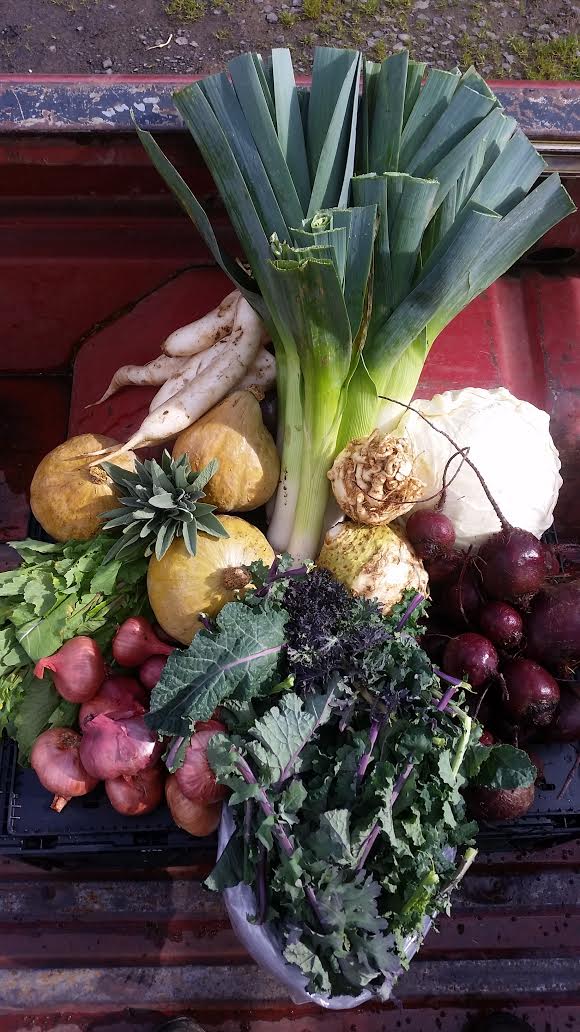In Your Share This Week
- Beets, red
- Cabbage, green
- Celeriac
- Herb, sage
- Kale, mix
- Leeks
- Mustard Raab
- Radish, daikon
- Shallots
- Winter Squash, Baby Blue Hubbard
Around the farm
During that spurt of sunny weather we had last week we were plenty busy on the tractors, turning old sections of cover crop or dead plant debris into the soil for our early season crops like radishes, chard, fennel, lettuce, and the like. Our garlic is looking happy as it pokes up from its bed of alfalfa mulch, and little fava and pea sprouts are emerging from fields that were broadcast seeded earlier in February.
The greenhouse is also filling up with starts at an exciting rate. Our heated portion of the greenhouse features onions, kales, salad mix ingredients, flowers for attracting beneficial insects, herbs, head lettuce, spinach, a golden beet trial, and more!
New parts have arrived that will get an old, abandoned direct seeder up and running for the 2016 season, which we hope to begin trials with soon. It mounts to the back of a tractor, allowing one person to seed multiple lines down the entire length of a bed in just one pass. It also ensures that all the lines are evenly spaced and straight, which will allow for easier and better weeding with our cultivation tractors later on. These little improvements are the types of exciting innovations that allow us to gain efficiency and thusly focus more time and energy on other important aspects of the farm.
The hedgerows are also bustling with life this time of year! Sauvie Island is well known for its diversity of avian life (you can find about 250 species on the island)- and its a real treat to hear the bird songs all day while we are working. Hummingbirds are also appearing more frequently as the Red Flowering Currants are beginning to bloom- a favorite food source.
Share Notes
Cabbage: These green cabbages have been awaiting harvest all winter long in the furthest outer reaches of our farm fields…and now they are ready for you! This is a pretty variety called Daedon that has purple-tinged outer leaves. Alas, those outer wrapper leaves take all the beatings from the elements and must be peeled away to reveal the well-protected interior.
Leeks: Another great late-season crop that holds forever and ever in the fields. We still have a decent sized block to harvest from and are excited that they just keep growing without showing signs of bolting. We are about to come full-circle on the farm as we will still be harvesting leeks until nearly the time when we start our new babies in the greenhouse.
Mustard Raab: The farm is starting to show the signs of spring- lots of little yellow flowers abound as our overwintering brassicas like kales, mustards, mizuna, and asian greens bolt and flower. This provides great bee forage this time of year when there isn’t much else available but we sometimes have warm sunny days that motivate the bees to leave the hive. If you harvest the flowering stems just before or as the buds open into full flower, its a tasty treat that is somewhat reminiscent of asparagus. I usually prepare it just like asparagus- a quick sautee in a a very hot pan with garlic and finished with olive oil, salt, and a sprinkle of lemon juice. The raab bunches are a rainbow of mustard varieties from Wild Garden Seed’s mustard blends we grow for salad.
Radish, Daikon: You may find entire roots in your share, or portions that have had tops and tips cut off due to pest damage. We have also found that during their time in storage, the soil really glued itself on there pretty well- so the roots have been sprayed and washed but we were not able to get them as sparking white as you might recall them being earlier in the winter. You could give the skins a quick scrub prior to using to get the last little bit.
Sage: We have seen just enough new growth on our sage plants to harvest for the share. Sage goes well with just about anything containing potatoes, as well as celeriac. Try making a brown butter sage sauce, or putting half the bunch in a chicken before roasting. The sage will dry easily just like the thyme- so use what you need now and leave the rest on the counter, or hang upside down with a rubber band tightly secured around the base to dry it out more completely.

